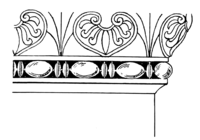Rod (ornamentation)

In ornamental art, the term rod is used to describe narrow decorative elements with closely lined up (serial) and mostly geometric individual forms that appear within a larger decorative context (e.g. on window and door frames, archivolts , picture frames or pieces of jewelry). Bars have no particularly accentuated beginning or end pieces; Regularly recurring interruptions or loosening up of the respective motif by means of spacers are possible (especially with pearl rods ). Bars usually serve as frames.
In addition to these ornate bars, there are also smooth bars . These are characterized by a smooth surface and differ in their profile.
Other ornamental shapes in a row are usually much wider and are therefore only suitable to a very limited extent as frames or borders, e.g. B. arched frieze , tooth cut , meander , wavy ribbon , garland , braided ribbon . They are usually not referred to as a "rod" but rather as a "band" or " frieze ".
Basic shapes of smooth bars
The following basic forms can be distinguished (see picture next to it):
- Bar (it. Listello )
- Cave (it. Cavetto )
- Arching (it. Tondino )
- Egg ( lat.ovulum , it.ovolo )
- Bead (lat. Torus , it. Toro )
- Throat ( lat.gula , it.gola )
- inverted throat ( lat.gula reversa )
- Owl's bill (it. Becco di civetta )
- Scottish (it. Scozia )
history

Lines of one and the same motif can be found in almost all stylistic periods of European art since antiquity at the latest . In the older non-European ornament art, on the other hand - apart from some regions of India - they rarely appear.
Occur
Bars can be arranged horizontally as well as vertically or in arches, but they do not repeat themselves in the same shape next to one another or in the area (exception: lattice bars). In goldsmithing and glass art as well as in ivory carving and cabinet making , rod motifs are often found as framing; occasionally they can also be found in works of medieval book illumination . In architecture, bars usually appear on portal walls and in the frames of windows etc .; they also appear on carved wooden frames (e.g. picture frames ) or stucco work .
Manufacturing
Rod shapes are comparatively easy to manufacture. In order to avoid unwanted overlaps, breaks and other inconsistencies, however, precise measurements must be made beforehand - the motif is then applied to the material to be processed by means of a preliminary drawing or scratching. While rods were always custom-made in earlier times, industrially prefabricated rods made of wood, plaster of paris, metal or plastic can now be purchased.
symbolism
In earlier times, rod shapes formed a sovereign - reminiscent of goldsmith's work such as gemstone chains or strings of pearls - a picture motif, a portal entrance or a (window) frame. The rather rare star rods clearly refer to the heavenly sphere.
Since the baroque , at the latest since classicism and historicism , rod shapes have largely lost their symbolism and can generally only be understood as pure decorative elements.
Types
Depending on the motif, one differentiates among other things
- Round bar
- Profile bar
- Egg stick
- Bead stick
- Ball stick
- Diamond rod
- Perforated rod
- Rope rod
- Leaf stick
- Rosette rod
- Star rod
There is also the more general designation astragalus for the shapes of round rod, pearl rod and egg rod .
See also
Individual evidence
- ^ Astragalus in the art dictionary by PW Hartmann.




